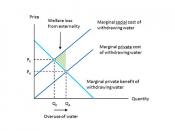Similarities and Differences between Common Goods, Public Goods, Private Goods, and Natural Monopolies
Identify similarities and differences between common goods, public goods, private goods, and natural monopolies. Provide an example of each type of good and justify your answers. Discuss possible positive or negative externalities associated with each example. How do the externalities affect the economy?
Similarities
Each is guided by the economy.
Differences
Each is unique and different in reference to rival and exclusion.
Examples/Externalities
Common goods: rival but not excludable. Interstates and public highways would be a good example because it is shared by all and beneficial to all members of society. A negative externality derived from the use of interstates and highways could be the greenhouse effect caused from gas emissions from vehicles traveling on them.
Public goods: neither excludable nor rival. Public parks would be a good example because one persons use of does not diminish another persons use, and there are no restrictions for the use.
A negative externality could be that public parks attract unsavory characters i.e. drug dealers, rowdy teens etc. A positive might be that it's a nice place to hold birthday parties, weddings etc. with large groups.
Private goods: both excludable and rival. Personally owned vehicles (POV's) would be a good example because one person's use of it would diminish another person's use of it, and the use of it is restricted by the owner. A negative externality might be air pollution caused by gas emissions.
Natural monopolies: excludable but not rival. Electricity would be a good example because it can be restricted to only those who pay for the service; however, one person's use of it does not diminish another person's use. A positive externality might be the social benefits of production and consumption of electricity i.e.


